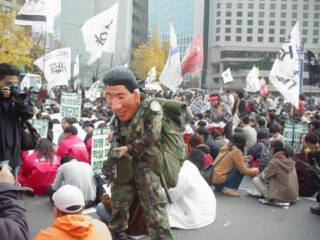North Korea 'watchers' spend most of their time craning their necks trying to catch the tiniest tidbits of information coming out of the most secretive regime on earth / hermit kingdom / Leninland / rogue state (delete according to your preferred cliche). But recently a whole load of
tidbits have come along at once taking up half the road like a load of shiny new No. 12 bendy buses. First there were the disappearing
portraits (Kim Jong-il's face has gone from the walls of buildings frequented by foreigners in Pyongyang), then the disappearing
generals (rumours are rife that a number of high ranking be-medalled types have done a runner to China or the US) and then the disappearing
food (this year despite a bumper harvest in the DPRK the country will still need plenty of help from the WFP because farmers appear to be taking advantage of the new market reforms to hoard their crops, ironically causing food shortages for the urban bureaucracy).
At
NKZone Andrei Lankov has linked a couple of excellent articles (
1 and
2) of his on changes in the DPRK. Rather than focusing on the odd juicy but unproven story, he looks at a whole range of indicators showing what has been happening in the country over the last few years.
There are a few things that really stood out in Lankov's articles. First, writing like this really knocks on the head the nonsense about how we know nothing about North Korea - if you're willing to look there's plenty of information out there, and I suspect that US intelligence knows plenty more too.
Second, there's Lankov's conclusion that North Korea is now basically capitalist. Well I wouldn't argue with that because I don't think it's ever been anything but part of the world capitalist system (albeit in its own peculiar way). But I suppose the more significant thing is that he is pointing out just how much an informal market system has come to replace the old centrally-planned state capitalist system.
Third, something that really caught my eye was Lankov's description of the fascination that the urban middle classes and younger members of the elite have developed for South Korean culture:
The first VCRs turned up in the North around 1990, but for a decade they remained beyond the wildest expectations of the average North Korean.
The situation changed around 2000 when northeast China was flooded with cheap DVD players and newer VCRs. Old machines are now sold very cheaply by their owners, and then smuggled to North Korea via its porous (essentially, uncontrolled) border with China. In North Korea the used VCRs are resold at high premiums, but a machine still only costs the equivalent of US$35 or $40 - definitely within the reach of a more successful North Korean family. VCRs are largely used for copying and watching tapes of South Korean TV soap operas, which have become major hits in North Korea in the past few years. The South Korean actors and actresses are much admired, and their hairstyles and fashions are eagerly imitated by the Pyongyang youth.
The more affluent, better-educated and younger segments of the population are more eager to fall under the spell of this "imperialist pollution" - much like the former Soviet Union, where in the 1970s and early 1980s the scions of the party bosses were avid watchers of James Bond movies and proud consumers of Levi Strauss' blue jeans. Younger North Koreans are no different, and it is the youth from the best universities, largely well-connected - spoiled brats, some say - who now sport the eccentric haircuts and outfits straight from the Seoul TV shows. Even a few North Korean students have dyed their hair, mimicking South Korean fashion. (Visitors from the North didn't say whether anyone they saw dyed his or her hair green or adopted a punk hair style, but anyone apart from the severe, heretofore unchanging norm is notable).
Reading this suddenly reminded me of
Vladimir Tikhonov's (박노자) description in the introduction to his excellent book
Tangsindul ui Taehanmin'guk of his disillusionment with his generation of young Russians and their turn away from politics and social movements toward consumerism and a fetishism of things Western.
Of course we all know from the Russian example how easy it can be for the state capitalist nomenklatura to transform itself into a free marketeering oligarchy. What worries me is that in the absence of change based on workers' struggles in the North, the privileged layers of North Korean society could become the best allies of the old rightwing establishment in South Korea and their pals in Washington. Certainly, we've already seen a number of high-level North Korean defectors (most prominently Hwang Jang-yop, the supposed architect of Juch'e thought) end up far to the right of even the South Korean government, with said government having to keep them practically under house arrest in Seoul so that they won't swan off to Washington to whisper sweet nothings into the ears of assorted Neocons.
One other thing: I liked this
story from the English section of
OhMyNews on computing in North Korea. Apparently people there know about the computer games like Starcraft that seem to obsess most South Korean young'uns. North Koreans take note: too much gaming can be
fatal.




